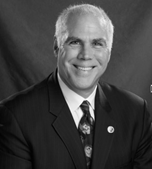Editor’s note: This is part one of a four-part series.
In 1961, President John F. Kennedy proclaimed that America would go to the moon. Such a wildly audacious statement was so far outside the boundaries of human experience that many considered it impossible. It was too bold. It was too quixotic. But it was also genius. President Kennedy said, “We will go to the moon; we will go to the moon, and do other things, not because it is easy, but because it is hard.” President Kennedy’s Moonshot speech galvanized our nation. It lifted us above our petty differences and invited us to place our focus on transcendent pursuits. It also inspired a new generation of Moonshot thinkers—scientists, technologists, engineers, mathematicians, artists, writers and teachers who endeavored to attain new heights. Eight years later, a mesmerized nation watched American Astronaut Neil Armstrong descend from NASA’s lunar module onto the moon’s dusty grey surface, making “One giant leap for mankind,” alone in the cold, dark vacuum of space.
A wide eyed eight-year-old with a penchant for getting into trouble, I sat glued in front of my family’s black and white television set as that historic scene unfolded. It filled me with an indescribable sense of wonder and awe. I had always wanted to be a scientist, but now I also wanted to be a fearless explorer. I imagined what it must be like to leave my footprints in untrammeled places. In 1984, I became a public school AP Biology teacher with a passion to both inspire my students and to contribute something of enduring value to the education profession. That was also the year I began researching the impact of educational technology on student achievement.
Brave New World
Nearly 20 years into the 21st Century, it is beyond argument that we now live in a world where agile adaptation to rapid change must be considered one of the new indicators of success in life and work. We have evolved from a world where “The Oregon Trail” was considered cutting-edge, to a VUCA world where Volatility, Uncertainty, Complexity, and Ambiguity are the new norms. But have our educational methods kept pace with these new 21st Century indicators of success?
Over the past 35 years, I’ve published numerous research studies, scholarly articles, and books on the subject of disruptive innovation in education. All my investigations have been focused on the singular purpose of helping students and teachers harness the potential of educational technologies to realize transcendent learning. By transcendent learning, I mean going well above and beyond the expectations and limitations that bind us to the “Tell and Practice” model of instruction. In that industrial-age model, teachers tell students what to memorize while students practice memorizing and retrieving that knowledge for formative and summative assessments.
The result of having students dutifully memorize old knowledge has been a dangerous status quo of minimum proficiency and mechanistic compliance to surface learning. Another more insidious consequence of the Tell and Practice model of instruction is a form of dependence: Students depend upon their teachers to tell them what to learn, how to learn and how well they are learning. This is the antithesis of building agility and adaptability for a VUCA world. Now, more than ever, we need an Educational Moonshot: A pedagogical breakthrough so extraordinary that student learning and achievement are exponentially boosted in such a way that assures our students are fully prepared for the VUCA future.
Research Matters
Education research matters. The reason it matters, particularly in the digital age, is that education systems are awash in evidence-free claims, promises, and outright fabrications. This begs the question: Have our investments in educational technologies resulted in sufficient return on investment? The preponderance of research evidence shows us the answer is a resounding “no.” In his most recent meta-analysis, renowned education researcher Professor John Hattie calculated that the average effect size educational technologies have on student achievement is a dismal .34, well below the average impact of .40 (Hattie, in Magana, 2017). The evidence indicates that we have developed learning systems that are digitally rich, but impactfully poor.
However, there is cause for renewed optimism. In my recent book, Disruptive Classroom Technologies, I’ve synthesized four decades of research into a highly reliable pathway for doubling student academic achievement which I call the T3 Framework for Innovation. The T3 Framework increments the impact of digital tools into three domains: T1) Translational, T2) Transformational, and T3) Transcendent. The strategies in the T3 Framework have an effect size of ES=1.6, which is equivalent to quadrupling student achievement. It is not only possible, but highly probable that implementing the precise sequence of T3 strategies with fidelity in our classrooms will lead to a doubling of student academic achievement. That my friends is an Educational Moonshot.
After a rigorous global peer-review process, The T3 Framework for Innovation was recently inducted into Oxford University’s Research Encyclopedia for Education. To have my findings published by what is arguably the pinnacle of education research is a high honor that is deeply humbling and gratifying. It is a testament to the gifts of knowledge I’ve gained from my students and and from my teachers. It is also a testament to the power of imagination; you see, the epidemic of low-impact technology use is a wicked problem that matters to me. I’ve discovered a resolution to this wicked problem after failing better for 35 years—and it all began with imagining a world where student achievement was doubled. We will double student achievement; we will double student achievement and do other things, not because it is easy, but because it is hard. That’s what makes it great. Take the T3 Challenge to double student achievement. Learn how by visiting www.maganaeducation.com.
About the author

Dr. Sonny Magana is an award-winning teacher, best-selling author, and pioneering educational technology researcher. His book Disruptive Classroom Technologies has received wide international acclaim as: “A visionary work; truly insightful and inspirational!” (Robert Marzano, 2017); “A brilliant breakthrough in our understanding and use of technology for learning (Michael Fullan, 2017); and, “A major step forward; Magana’s T3 Challenge is credible, powerful, and exciting let’s do it!” (John Hattie, 2019). An avid musician, yoga practitioner, climber, and bee keeper, Sonny was awarded the Milken Family Foundation Educator Award and the Washington Governor’s Commendation for Educational Excellence.
Look for the part two of the series, The Translational Impact of Digital Tools in the Classroom, coming soon.











